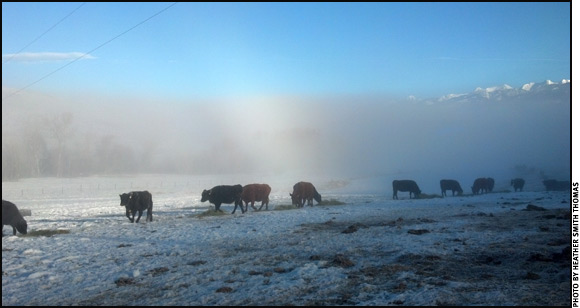
Temperature and wind chill greatly affect the amount of feed a cow needs to consume to regulate her body temperature during the winter months.
Factors that Affect Ability of Cattle
to Handle Cold Weather
Cold weather influences cattle feed intake requirements.
When days are short and weather is cold, cattle have ways to create more body heat and to conserve body heat: metabolism increases, feed intake increases and passage of feed through the digestive tract speeds up. Feed requirements for cattle may go up as much as 10%-25%, says Julie Walker, Extension beef specialist for South Dakota State University. All of these changes contribute to an increase in heat production, so the animal can withstand winter temperatures.
Cattle can tolerate colder temperatures if they have a good winter hair coat.
“As long as their heavy winter coat is dry, they are [more] comfortable at lower temperatures than if the hair is wet. Also, they do best if they have a chance to grow a good hair coat before extremely cold weather. If we go through a normal progression into winter and a gradual change, they can deal with it much better than when we had the blizzard of October 2013 here in South Dakota. Those cows were still in a transitional stage with a fall hair coat; they didn’t have their thick winter coats on,” says Walker.
“The rule of thumb we use is that for every 1° [Fahrenheit (F)] below a cow’s lower critical temperature she requires an increase of 1% in feed to keep warm — if she has her winter hair coat. Typically, if she has a dry coat, the critical temperature is about 19° Fahrenheit. If she has a wet coat (losing its insulating quality) that critical temperature goes up to about 60° Fahrenheit,” explains Walker.
Feed intake must increase to generate enough body heat.
“In the range from 23° to 41° Fahrenheit the increase would be 3% to 8%. If the temperature range is between 5° and 23°, we’re looking at a 5% to 10% increase in feed. If the temperature is lower than 5°, it would be [an] 8% to 25% increase,” says Walker.
It depends on temperature and whether cattle have protection from wind — since wind chill effectively lowers the temperature that these animals can handle.
Wind protection can greatly reduce the impact of cold.
“It also helps if you can provide bedding, in some situations, so they are not lying on frozen ground and suffering more heat loss. To reduce cold stress, there are several things we can do to reduce heat loss and increase the amount of heat produced by the animal via feed. Fermentation of forage is an excellent source of heat production,” says Walker.
Having cows in adequate body condition before they go into winter is very important.
“This helps them handle the cold much better than if they are thin, with very little fat covering. The impact of cold is totally different for a cow in a body condition score of 3 compared to one with a condition score of 6.”
The additional body condition serves as insulation and also provides some reserves of energy to draw from for heat production when temperatures drop.

Editor’s Note: Heather Smith Thomas is a freelance writer and cattlewoman from Salmon, Idaho.






